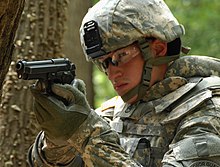Service pistol
This article includes a list of generalreferences,butit lacks sufficient correspondinginline citations.(February 2010) |

Aservice pistol,also known as apersonal weaponor anordnance weapon,is anyhandgunissued to regularmilitary personnelorlaw enforcement officers.Typically, service pistols aresemi-automatic pistols(previously revolvers) issued toofficers,non-commissioned officers,and rear-echelon support personnel forself-defence,though service pistols may also be issued tospecial forcesas a backup for their primary weapons. Pistols are not typically issued to front-lineinfantry.Before firearms were commonplace, officers and non-commissioned officers typically carriedswords.
History[edit]
Prior to the introduction of cartridge-loading firearms, there was little standardization with regard to the handguns carried by military personnel, although it had been important forofficers,artillerymen, and other auxiliary troops to have a means of defending themselves, especially as it was not always practical for them to have a full-lengthrifleorcarbine.
Traditionally, soldiers, sailors, cavalrymen, and officers had carriedswordsfor both personal protection and use in combat. The development of firearms in the early 14th century changed the way battles were fought, and by the late-15th century it was no longer especially practical to close in hand-to-hand combat range to engage one's opponents, owing to the prevalence ofpikesandmusket-fire(pike and shot) on thebattlefield.
Training was also a factor—it took a very long time to train new recruits in the use oflongbowsand swords—whereas the basic operation of anarquebuscould be taught in a comparatively short time. As a result, swords were retained only by officers (who were less likely to be at the front of the pike-and-musket hedge) and by cavalry, for whom early single-shot handguns were of limited use.
The invention of therevolverin 1836, finally made aservice pistolpractical, as prior to this pistols had largely been single-shot weapons usually of no particular standardized pattern.
Although officers traditionally had been obliged to buy their own weapons,non-commissioned officers(NCOs) and other enlisted personnel were generally issued their weapons (which they were then expected to either pay for or return to thequartermasterif they were promoted). Service pistols, on the other hand, were generally issued to officers, NCOs, and others who needed to carry personal weapons as part of their duties. Hence, it was quite common for officers to carry government-issued service pistols in combat.
The first service handguns were revolvers, but the development of semi-automatic pistols (the first practical example being theMauser C96 "Broomhandle") gradually led to their replacement by semi-automatic handguns, such as the well-known GermanP08 Luger,the first semi-automatic service pistol to be widely adopted by an industrialised nation.
The British Army was the last major military service to adopt a semi-automatic service pistol as a standard sidearm, phasing out theirWebley Mk IV,Enfield No 2 Mk I,andSmith & Wesson Victoryrevolvers in 1969,[1]after which theBrowning Hi-Powerbecame the Army's official service pistol.
Modern issue[edit]

Special operations soldiers often carry a handgun as a secondary weapon to serve in a supplementary capacity to their primary weapon (arifle,carbine,submachine gun,orshotgun); this practice is not as prevalent among conventional soldiers. Soldiers who do not serve in a direct combat role are often issued a pistol (such as officers, artillery crews, and other rear-echelon personnel), but conventional riflemen are not generally issued a pistol as part of their standard kit. However, drivers are often issued a handgun since, while driving, their rifle will be stowed on a rack and thus difficult to make ready quickly in an emergency, whereas a handgun is more easily accessible. Service pistols are issued tomilitary policeand other soldiers acting in alaw enforcementcapacity as part of their duties.
The tradition of issuing pistols to officers as a primary weapon is being phased out by many nations. TheUnited States Marine Corps,for example, requires all enlisted personnel and all officers below the rank ofLieutenant colonelto carry theM27 IARas their primary weapon.[2]British officers on combat duty are also normally issued with the standard rifle, but are not required to carry it with them at all times; for example, while operating as support staff the rifle would be stored in the base armory, though this is the same for most support staff.
See also[edit]
Notes[edit]
- ^Stamps, Mark, and Ian Skennerton,.380 Enfield Revolver No. 2,page 118
- ^Pike, Travis (2021-12-08)."The weapons the Marines passed on in favor of the M27 IAR".Sandboxx.Retrieved2022-08-25.
References[edit]
- Howdah To High Power(2002) Maze, Robert J, Excalibur Publications, Tucson AZ (USA)ISBN1-880677-17-2
- Small Arms Identification Series No. 9:.455 Pistol, Revolver No 1 Mk VI(1997) Skennerton, Ian, Arms & Militaria Press, Gold Coast QLD (Australia),ISBN0-949749-30-3
- .380 Enfield Revolver No 2(1993) Stamps, Mark and Skennerton, Ian, Greenhill Books, London (UK)ISBN1-85367-139-8
- 1942 Basic Manual of Military Small Arms (Facsimile Edition),Smith, W.H.B, Stackpole Books, Harrisburg PA (USA),ISBN0-8117-1699-6
